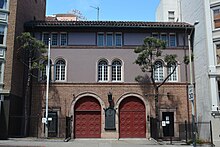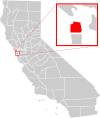Lower Nob Hill Apartment Hotel District | |
California Historical Landmark
No. N1708 | |
 | |
| Location | Roughly bound by 590–1209 Bush, 680–1156 Sutter, and 600–1099 Post Streets, San Francisco, California |
|---|---|
| Coordinates | 37°47′20″N 122°24′58″W / 37.789°N 122.416°W |
| Area | 57 acres (23 ha) |
| Built | 1906 |
| Architectural style | Late 19th And Early 20th Century American Movements, Late 19th And 20th Century Revivals, Renaissance |
| NRHP reference No. | 91000957 |
| CHISL No. | N1708 |
| Significant dates | |
| Added to NRHP | July 31, 1991 [2] |
| Designated CHISL | July 31, 1991 [1] |
The Lower Nob Hill Apartment Hotel District is a historic district located in the Nob Hill neighborhood of San Francisco, California, U.S.. It covers roughly a 5-block length in downtown San Francisco on the south slope of Nob Hill. It is sometimes referred to as the "Tendernob," the name is a portmanteau for the area that is the meeting point of the Tenderloin and Nob Hill. [3] [4] [5] The Lower Nob Hill Apartment Hotel District is listed as a California Historical Landmark since July 31, 1991; [1] and listed on the National Register of Historic Places since July 31, 1991, for architecture and social history. [6] [7]
Location
It covers roughly a 5-city block length in downtown San Francisco on the south slope of Nob Hill; in the south boundary of the district is adjoining the Tenderloin neighborhood, and in the west it is adjoining the Polk Street/ Van Ness corridor. [8] It is bound by 590–1209 Bush, 680–1156 Sutter, and 600–1099 Post Streets. [8] This district is located near other National Register of Historic Places defined historic districts, at the south is the Uptown Tenderloin Historic District.
There are social differences between living on the lower hill versus living in the "flatlands" of the Tenderloin, and researchers have defined the neighborhood break line at Post Street. [8] Since the early 20th century, the rents in the Lower Nob Hill have been higher than in the Tenderloin. [8]
Architecture
The Lower Nob Hill Apartment Hotel District is architecturally remarkable for its dense multiple-unit residential buildings, unequaled in quantity and quality anywhere in California except possibly in the Tenderloin. [8] It has 296 contributing buildings, and most are at the height of three to seven stories. [8]

Historically there has been a progression of many of the building types (in both the district and the city), from boarding house to lodging house to hotel to apartments. [8] After the 1906 earthquake, this district burned for three days and demolished all of the buildings. [8] Because of the outcome of the 1906 earthquake, virtually the entire district was constructed between 1906 and 1925. [8] The city enacted a rule for using fireproofing materials in the new construction. [7] Early buildings (1906–1910) tend to simple brick facades with a little corbeling; after about 1912 many buildings were influenced by Mission/Spanish/Mediterranean revival influence with flat brick or stucco facades; late buildings (1929–1935) tend to Art Deco, especially the Maurice Hotel at 761 Post Street, and 820 Bush Street. [8]
Notable architects and firms that designed building in the Lower Nob Hill Apartment Hotel District included Frederick Herman Meyer, Sylvain Schnaittacher, G. Albert Lansburgh, James Francis Dunn, Herman Carl Baumann, Charles Oliver Clausen, and Rousseau & Rousseau. [8] The streetlights at 680–1140 Sutter Street were designed by sculptor Arthur Putnam with "The Winning of the West" ( c. 1908) bases, installed with architects D. H. Burnham & Co. [8]
History

In 1911, William Lawrence Murphy the inventor of the Murphy bed, lived in the district at 625 Bush Street. [9] About a third of the buildings in the district were built for the 1915 Panama–Pacific International Exposition. [8]
Academy of Art University owns and uses several buildings in this area for both housing and educational purposes. [10] [11]
This district was the subject of Dashiell Hammett's The Maltese Falcon (1930) with the fictional private detective Sam Spade living in the area. [12] The film Vertigo (1958) by Alfred Hitchcock features a book shop named the Argosy that was inspired by the Argonaut Book Shop at 786 Sutter Street; and when Kim Novak walks into a hotel as the character Judy Barton, that hotel is now known as the Hotel Vertigo (1928) at 940 Sutter Street. [4]
In 1961, the Tay-Bush Inn raid occurred at 3:00A.M. at roughly 900 Bush Street. [13]
List of notable buildings

- Victoria Hotel (1907), 590 Bush Street [8]
- Beck Apartments (1909), 660 Bush Street; architects Cunningham and Politeo [8]
- Angelus Apartments (1911), 645 Bush Street; architects Righetti and Headman [8]
- Colonial Hotel (1912), 650 Bush Street; architects Cunningham and Politeo [8]
- Calvert Hotel Apartments (1913), 637–639 Bush Street; architects Righetti and Headman [8]
- Edison Apartments (1914), 618 Bush Street; architects Rousseau and Rousseau [8]
- Dennis T. Sullivan Memorial Fire Chief's Home (1922), 870 Bush Street; listed as a San Francisco Designated Landmark [14]
- The Gaylord Hotel (1929), 620 Jones Street; architect Herman C. Baumann [8]
See also
- California Historical Landmarks in San Francisco County, California
- National Register of Historic Places listings in San Francisco
- Hotel Carlton
References
- ^ a b "Lower Nob Hill Apartment Hotel District". Office of Historic Preservation, California State Parks. Retrieved May 26, 2023.
- ^ "National Register Information System". National Register of Historic Places. National Park Service. November 2, 2013.
- ^ Stannard-Friel, Don (2005). City Baby and Star: Addiction, Transcendence, and the Tenderloin : Book One of the Voices from the Edge Trilogy. University Press of America. p. 33. ISBN 978-0-7618-3069-6.
- ^ a b Hession, Stephanie Wright (November 3, 2011). "Sutter Street, Lower Nob Hill, S.F.:". SFGATE. Retrieved May 26, 2023.
- ^ "San Francisco". refinery29.com. March 27, 2008. Retrieved May 26, 2023.
- ^ "Lower Nob Hill Apartment Hotel District". NPGallery, Digital Asset Management System.
- ^ a b "National Register #91000957: Lower Nob Hill Apartment Hotel District in San Francisco, California". noehill.com. Retrieved May 26, 2023.
- ^ a b c d e f g h i j k l m n o p q r s t "National Register of Historic Places Inventory/Nomination: Lower Nob Hill Apartment Hotel District". National Park Service. July 31, 1991. Retrieved May 26, 2023. With accompanying pictures
- ^ "How A San Francisco Love Story Inspired the Invention of the Murphy Bed". KQED. July 16, 2020. Retrieved May 26, 2023.
- ^ "S.F. City Attorney Sues Academy of Art for Illegal Building Conversions". KQED. May 6, 2016. Retrieved May 26, 2023.
- ^ Sisto, Carrie (July 29, 2019). "Academy of Art University master plan advances, offers new affordable housing & community benefits". Hoodline.
- ^ Kamiya, Gary (November 3, 2020). Spirits of San Francisco: Voyages through the Unknown City. Bloomsbury Publishing USA. p. 22. ISBN 978-1-63557-589-7.
- ^ "1961 police raid pivotal for gay rights in S.F." SFGate. June 22, 2013. Retrieved July 15, 2018.
- ^ "San Francisco Landmark #42: Dennis T Sullivan Memorial Fire Chief's Home". noehill.com. Retrieved May 29, 2023.
![]() This article incorporates
public domain material from websites or documents of the
National Park Service.
This article incorporates
public domain material from websites or documents of the
National Park Service.
External links
-
 Media related to
Lower Nob Hill Apartment Hotel District at Wikimedia Commons
Media related to
Lower Nob Hill Apartment Hotel District at Wikimedia Commons
- Nob Hill, San Francisco
- National Register of Historic Places in San Francisco
- Historic districts on the National Register of Historic Places in California
- California Historical Landmarks
- Art Deco architecture in California
- Mission Revival architecture in California
- Spanish Revival architecture in California
- Mediterranean Revival architecture in California


